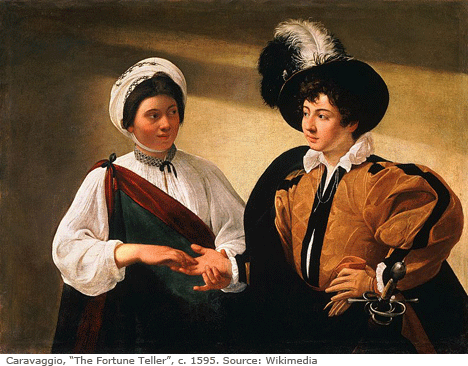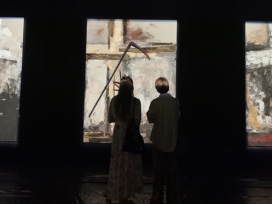Is Europe anything more than the remnants of a grand political delusion? Is there a cultural bond that unites the nations and peoples of this fragmented continent? From Max Weber to Norbert Elias, the greats of European intellectual history have described and re-described Europe as the birthplace of modernity; not, like the other continents, as the “heart of darkness”, but as the energetic centre of civilizing progress. Their attention has focused on the “grand narratives”: industrialization and economic productivity, state and nation building, science and art. Yet might not an examination from the other side – through an investigation of the marginal – provide essential insights into Europe’s development over the longue dureé? Might not the history of the Roma, a group marginalized like none other, reveal a less auspicious aspect of Europe’s grand narrative of modernity?
The tendency of existing research to treat the Roma as having first entered European political history with the Nazi genocide disregards a unique six-hundred-year history. It is indeed the case that the Roma, who over long periods of time lived nomadically and possessed no written culture of their own, have left almost no historical accounts of themselves. The heritage and documents therefore do not permit a history of the Roma comparable to that, for example, of the persecuted and expelled French Huguenots. What is available to us, however, is evidence – in the form of literature and art – of the way in which the settled, feudally organized European population experienced a way of life that it perceived as threatening. Despite consisting solely of stories and images that are defensive “distortions”, this evidence provides a far from unfavourable basis for an examination of the six-hundred-year history of the European Roma, insofar as it is a history of cultural appropriation characterized by segregation. We encounter the traces of the reality experienced by the Roma almost exclusively through depictions by outsiders, and must use these to imagine those parts considered impossible to represent. The extraneous cultural depictions of the Roma – variously referred to as Gypsies, Zigeuner, Tatern, Cigány, Çingeneler, and so on – have created heterogeneous units of “erased” identity and cultural attributes. The “invention” of the Gypsy is the underside of the European cultural subject’s invention of itself as the agent of civilizing progress in the world.
The Roma occupied a unique position from the outset. They belonged to those who were not there from the beginning, who were not expected and who therefore had to disappear again. They were seen as sinister because they “lurked everywhere” and “came and went” according to inscrutable rules. This gave rise to a uniform moment of perception and encounter: the ambivalence of contempt and fascination. A repository of stereotypes, images, motifs, behavioural patterns and legends developed early on, at the transition from the Middle Ages to the modern period. Repeatedly, exterminatory fantasies turned into exterminatory practices.

Secrets of origins
The Roma arrived in Europe by various means in around 1400. One barrier to their acceptance was the uncertainty regarding their origins. While groups such as the Germans, Gauls, Angels and Saxons had developed national myths of foundation and origin in order to corroborate their arrival in and occupation of a particular territory, the first legends about the Roma told of their mysterious and distant origins and failure to settle. Speculations as to their genealogy led to the first attempts to categorize them. If it was true, as the Roma themselves sometimes claimed, that they came from “Egypt”, where they had lived at the time of the birth of Christ, then, argued the European countries to which they had immigrated uninvited, the “Egyptians” should return to the country of their ancestors.
The matter of descent was also directly tied to the – for the period – fundamental question of religious affiliation. Since Roma communities did not practice institutionalized Christianity, with its parishes, priests and churches, three theories emerged as to the Roma’s religion. The first was that they adopted the various Christian confessions merely superficially. Many – for example Martin Luther – believed it to be typical for the Roma to undergo multiple baptisms in order to acquire presents and documents. Second was the allegation that the Roma were Turkish spies, which in turn made them Muslims. Third, there were those who seriously believed that the Roma practised heathen or satanic cults. Their soothsaying, healing charms and curses seemed to provide evidence for this. For similar reasons, the charge of cannibalism re-occurred repeatedly. All three theories persisted into the twentieth century.
Roma social structure was seen as very simple and its rulers’ genealogies not worthy of examination: on the one hand there was the “king” or “duke”, identifiable by his insignia and clothing, who, in the fifteenth century, could still produce letters of patrimony and protection from sovereign princes or even kings and popes; on the other was his “people”, which generally included no more than a few dozen individuals. The documents and literary works telling of the migrants form a space of inattention, inaccurate observation and lax description, in which the Other was created rather than described.
Stateless, homeless, placeless
The question of territorial location was a further hindrance to the acceptance of the Roma. Insofar as it is possible to gather from the sparse sources, the initially nomadic lifestyle of the majority of Roma groups led to their identification – albeit soon abandoned – as refugees or pilgrims. The gradual rise in the course of the early modern period of the national territorial principle and the territorialized way of thinking that underpinned it caused the Roma’s lifestyle to be perceived as a subversive attempt to disassociate themselves from social, legal, economic and cultural ties. Modern territorialized thinking assumed that everything on the Earth, including the land itself, was someone’s property and had an owner. This created an affective identification with geographical givens, exemplified by the nineteenth-century German concept of Heimat (“home”). The subjective attributes of “property” and “home” therefore had to be established, guaranteed, delineated and mapped by acts of law and power. Territorialized thought became an understanding of normality that posited one’s own way of life as an absolute standard. Under these conditions, what home could be accorded to the Roma except for the streets, the unpopulated forests and heaths, and the uninhabitable margins of European civilization, the swamps and steppes?
The symbolic charging of European topography and the new geopolitical order increased the Roma’s segregation. Although they generally remained within a limited geographical radius over several generations, they were seen as aliens without a home or place of their own. Between 1650 and 1750, territorialized thinking turned into state terror against the Roma. Reviled as “vagabonds”, they were no longer tolerated on the lands of most rulers. At some borders, special “Gypsy tablets” were put up depicting in pictures, for those who could not read, the punishment awaiting anyone who entered: from beatings or branding to death on the breaking wheel.
Prohibitions on entering national territories meant constant persecution and expulsion for the Roma. They prevented any possibility of long-term planning and de facto meant a shortening of life expectancy as a result of poverty, undernourishment and poor health. In the eighteenth century, some states such as Spain and the Austria of Maria Theresia and Joseph II sought to impose the territorial principle on the Roma through forced settlement. These measures aimed to prevent the nomadic lifestyle and compelled the Roma to adopt Catholicism and abandon their own language.
The image of the Gypsy camp and its threatening inhabitants became the inversion of “home”. It ranged from robbers’ dens in the forest and the kral (camps) of the Roma in the south eastern European steppe to the cave dwellings of the Spanish Gitanos and to the Zigeunerlager set up separately in Auschwitz-Birkenau. The dwellings of the Roma were seen neither as a private sphere deserving of respect nor as a cultural asset worthy of protection. On the contrary, numerous literary works extolled their destruction as a civilizing act.
Fascination: The beautiful Gypsy
The “beautiful Gypsy” counts among the most potent images in the European cultural imagination. The figure is not, as is often assumed, the product of European Romanticism or English Victorian literature, even if it is the Zemfiras, Esmeraldas and Carmens that have become indelibly imprinted on the cultural memory. Cervantes’s 1613 novella La gitanilla had already evoked the “Spanish” dress, the singing and dancing as well as the “wild” femininity untamed by modesty that later became popular. The crucial aspect of the stories recounting encounters with “beautiful Gypsies” is something else: they are neither allowed to marry the male members of the majority population nor do they permanently abandon their nomadic lifestyle. The narrative arc of their lives generally ends prematurely: either they die at the hands of their jealous lover or they wither and fade in the civilization that they experience as captivity.
As is typical in exoticist and Orientalist discourses, with which it overlaps, the figure of the “beautiful Gypsy” acts as an object of male sexual desire. Anti-bourgeois behaviour, “natural” femininity, dangerous wildness, promiscuity and, indeed, paedophile fantasies are projected onto her. In August Strindberg’s story Tschandala (1889), the male protagonist describes a sexual encounter with a young Gypsy barely older than a child: “He had embraced an animal, and after the embrace the animal kissed him like a cat, and he turned away as if he feared that his soul would meet an animal soul on those lips, as if he feared breathing in impure air.” The “beautiful Gypsy” alienates through her secretive unattainability even at the most intimate moments and her withdrawal into a concealed, uncivilized order or animalistic sphere.
Social deviance
The Roma could only be placed in the social structure of early modern societies on the basis of a premise that had far-reaching consequences: the denial of their status as a people, even a small one. If they were not a people, then they could be classified among the mass of “vagabonds” that existed outside and beneath the social hierarchy and who attempted to survive through casual labour, begging and crime. Degraded to a band that merged with the army of the vagrant poor – the “rogues” and “vagabonds” described by contemporary sources – the Roma lost their special position as an ethnic group. Their lifestyle was now interpreted within the discourse of social deviance and criminality and thus in a different context to that of ethnic genealogy and typology. There is a direct progression from the thieves’ and beggars’ guilds described in the Liber Vagatorum, a pamphlet describing different types of beggar first published in Germany in 1510, to the “rogues’ galleries” and “wanted posters” of the end of the nineteenth century and the psychological dossiers of criminals of the early nineteenth century, to the theories of degeneration and criminal biology of around 1900.
In this discursive space, anthropological characteristics and ethnic particularities were successively re-construed to form the image of a criminal and parasitic group, until its members came to be seen from birth as lawbreakers without rights. In a sense, a criminal profile for every member of a Roma family was created: for old women no less than for men, women and even children. Notorious accusations that persist until this day include, alongside theft and swindling, the abduction of children – in other words, the devious intrusion into the family genealogy of the majority population.
The interpretative power of science
In the last third of the eighteenth century, Enlightenment anthropology and historical linguistics brought, albeit accidentally, new insights into the Roma that dispelled early modern speculations about their origins and language. The discovery of a genuine “Gypsy language” descended from Sanskrit that clearly indicated the Roma’s Indian origins was little short of a sensation. Linguistic research methods made it possible to retrace, on the basis of language levels and loan words from other languages, the Roma’s migration routes to Europe geographically, if not chronologically. The scholarly work summarizing these findings, Heinrich Grellmann’s Historischer Versuch über die Lebensart und Verfassung, Sitten und Schicksahle dieses Volkes in Europa, nebst ihrem Ursprunge (“Historical Essay on the Lifestyle, Customs and Destiny of this People in Europe, Alongside their Origins”, 1783), immediately met with considerable interest in other European countries and was quickly translated or transcribed.
The Enlightenment anthropologists believed that, as Indian descendants of the “Indo-Germanic” ethnic and linguistic family, the “Gypsies” were entitled to a higher status in the hierarchy of peoples than that of a lawless band. From an anthropological perspective, the Roma’s possession of their own language preserved over centuries represented their most important cultural asset. For the short period of a few decades, there were indications that an “enlightened” perception and categorization of the Roma might be possible in academic discussions and in individual works of Romanticism, the most progressive variations of which included vague ideas of equality. However, these tendencies failed to establish themselves in the long run. Anthropological concepts of the period judged the civilizational level of a people according to its ability to retain and cultivate a territory, to create an institutionalized state order, and by the status of its written culture. Whereas in this period the Basques – to cite just one significant example – advanced their “identity politics” to a new level through the creation of a written language, there were not efforts among the Roma in this direction.
Enlightened thinkers also inspired a few brutal settlement projects. These sought to “raise” the Roma lifestyle to the level of the European lower classes rather than integrate them on an equal basis. They failed for various reasons. The most important of these assimilation projects was the attempt to eliminate the orally inherited “Gypsy” language in order to prevent communication with nomadic groups. For the philanthropic reformers, the Roma did not pass the test of civilization, again proving themselves to be devoid of culture and incapable of development in all respects. Thereafter, anthropological knowledge was increasingly devalued and reinterpreted. This was also true for the language: while it was related to “ours”, it was, in the words of the German philologist and writer Gustav Freytag, no more than “a degenerate daughter of the noble Sanskrit”. Moreover, it was argued that in their Indian home the Roma belonged at best to the lowest caste of the unclean and untouchables. Once more they were seen as a natio infamata, as an ignoble, contemptible people on a level with the “Hottentots”, “Oceanic Negroes” and “Patagonians”, whom anthropologists had placed at the bottom of their ethnic hierarchy.
In the last third of the eighteenth century, detachment and ignorance gave way to increasing knowledge about the origins, customs, mores and languages of the Roma. Yet despite being more accurate and reliable, this knowledge actually increased the distance to the Roma rather than reducing it. It emphasized the Roma’s Otherness and sought to trace it back to fundamental civilizational differences. Civilizational development was now measured according to distance to the Roma. Even the most “backward” peoples of eastern Europe were reassured by the comparison with the “Gypsies”, since they imagined that they had an inferior people to look down upon.
Romantic fascination
The literature of European Romanticism contributed along with later post-Romantic music and painting to the popularization of the much celebrated “merry Gypsy life”. Nikolaus Lenaus’ poem Die drei Zigeuner (1838) was set to music numerous times; with its protagonists who smoke, sleep and fiddle long into the day, it became the symbol of the Gypsy way of life. The Romantics read and absorbed works of Enlightenment anthropology and historical linguistics and some even sought to learn Romanes, in order to encounter the objects of their desire “in the wild” and thus decipher their secrets. The Romantics, motivated by an interest in popular legends, the archaic, the uncanny and the revolt against the bourgeoisie, created a conspicuously large number and wide variety of Gypsy characters. The best-known include Isabella von Ägypten in Achim von Arnim’s eponymous novella (1812), Meg Merrilies in Walter Scott’s novel Guy Mannering or The Astrologer (1815), Zemfira in Alexander Pushkin’s poem Tsygany (1827), Esmeralda in Victor Hugo’s Notre-Dame de Paris (1831) and Prosper Mérimée’s Carmen (1845). Writers at the beginning of the nineteenth century imagined a secretive space apparently hidden away by the Gypsies: an invisible world somewhere out in the wild or within their “black” souls – perhaps even a paradise lost to modern industrial society, an island of autonomous life.
It is not difficult to find in this relationship between the real and imaginary, the banal and the miraculous, the grotesque and the beautiful, an affinity to the artistic self-conception of Romantic poets. In the mid-nineteenth century, artists identifying with the Gypsy life, or at least what they imagined it to be, began calling themselves La Bohème, or bohemians. The term “Gypsy romanticism” soon became established to describe their idealized, sentimentalized depictions. The Romantic writers did not place their Gypsies in the modernized present of industrial nation states but against a pre-modern backdrop, for examples Scott’s Meg Merrilies, who inhabited the ruins of an old Scottish castle. This contradiction seems to have been artistically fruitful: Romanticism brought about the largest and most enduring impetus in the aestheticization and medialization of the Gypsies. In almost all European cultures a multitude of stories and images circulated of an archaic, free and occasionally dangerous and threatening group on the margins and in the nooks of modern disciplinary society. Over the nineteenth century, Gypsies became a popular subject for entertainment: Gypsy themes were appropriated so often that they lost their originality, the images and stories often becoming trivialized. Understood as media, it was not knowledge about the Roma that these works were communicating, but something else: Gypsy romanticism was often a medium to communicate female eroticism and sexuality, which bourgeois decorousness demanded that one could only allude to if not omit entirely.
Medialization did, however, liberate the works of art from contemporary discriminatory characterizations. Nevertheless, the prioritization of stylization and typification over realism meant that few original depictions of high aesthetic quality emerged, and soon a banal pseudo-folkloristic Gypsy romanticism predominated, its icons the Hungarian fiddler and Andalusian flamenco dancer. Constant repetition generated predictability and led to a semantic void. Trivial Gypsy romanticism conjured up a distorted reflection of the reality of Roma life or was superimposed over it to the point of hiding it entirely. Compared to the reality, Gypsy romanticism appears as contempt for the Roma through artistic means.
Ethnology, or the de-Europeanization of the Roma
European ethnology was flourishing in the nineteenth century and the Roma provided a fruitful subject of investigation. The fact that this oral society had successfully resisted modernization meant that ethnologists were able to try out their methods in their direct vicinity. The activity of amateur researchers and professional scholars was considerable. A fraternity of “friends of the Gypsies” emerged in Europe and a lively exchange took place via journals and private correspondence. The highpoint was the foundation of the British Gypsy Lore Society, a society for research on the Gypsies’ lifestyle (which continues to publish its own almanac). Ethnologists systematically documented examples of material culture and recorded oral traditions such as jokes, fairy tales and legends. Franz Liszt’s oft-discussed studies of Gypsy music and Gypsy virtuosos were part of this. There was a significant increase in travel writing in which the collected material was given literary treatment. Nineteenth century ethnology assessed the “value” of an individual people according to its level of social organisation: starting with the family at the bottom, rising to the horde and the tribe, and ending with to the people, the nation and the state. In the transition from anthropological to ethnological research, the Roma were demoted from the status of a “people” to that of a “tribe”; as a tribal society, they were no longer a pre-modern but a pre-civilisational people living in a state of nature – like the North American “Indians” and the Africans. As with anthropology, ethnological descriptions defined them as elemental, stationary societies (i.e. societies incapable of development) whose parasitic existence threatened the majority (“host”) society.
Even where it was inadequate and inaccurate, ethnology dispelled some of the Roma’s exoticism. However the distance to them was not reduced and the decisive yardstick – one’s own, supposedly more valuable degree of civilisation – remained. Depreciatory judgements such as the following were still common:
The Gypsy possesses without doubt a high level of natural common sense and skill; from this comes the resourcefulness and trickery that he uses to achieve his ends. […] Honesty is not considered to be one of the virtues of this people, which since its first appearance has been described as mendacious and larcenous. […] Certainly he also sometimes displays a childish naivety or tries to impress with cheek and impertinence. In general this people possesses a large dose of arrogance and an excessive self-regard.
The closer ethnology got to elementary activities such as personal hygiene, medical treatment and eating habits, the greater the distance to the ethnologists’ own culture. Such activities were the basic testing ground of ethnic constructions of difference. Ethnology created the Gypsies as a marginal people on the peripheries of European high culture. This people were supposed to be thankful for what the civilized peoples left them. This did not yet mean the rubbish dumps, polluted industrial wastelands or useless spaces underneath motorway bridges that one finds today throughout Europe, but rather the uncultivated rural peripheries into which the Gypsies were to be driven. This phase of perception and categorisation is what I would like to call the second de-Europeanisation of the Roma, following the first perpetrated by Enlightened anthropology. It presented the body, thought and behaviour of the Roma in such a way that their otherness again acquired threatening contours. There was no space within Europe for them. Ethnic cleansing always begins on paper.
Racism and biopolitics
The image of Gypsies that had been established over nearly six hundred years was by no means dispelled by racial theories. On the contrary, existing denigration and contempt was re-defined and intensified. These changes did not take place in all European countries to the same degree. They were centred, of course, in Germany. Nevertheless, in almost every western European country, the new criminal theories based on biology intensified police and bureaucratic persecution of the Gypsies. In the first half of the twentieth century, the image of a criminal band of swindlers, thieves and infant abductors gained renewed prominence. The forensic sciences viewed Gypsies as “born” criminals who inherited their criminal characteristics. As an entire ethnic group – and not just as single family units – they were characterized as “antisocial”, “socially deviant” and “workshy”, with a pathological peripateticism. Under Nazi rule, these views became increasingly intertwined and were systematically propounded to justify the mass murder of the Roma. It was therefore not “knowledge” about the Gypsies that made state violence seem necessary but, conversely, the fact that after 1933 there was a power capable of imposing a particular “knowledge” on all areas of social and statutory life. Criminal and social theories based on race and biology also became influential from the end of the nineteenth century in other European countries and the USA. Here, too, they were increasingly employed in the planning, implementation and justification of socio-political sanctions limiting basic individual rights or doing away with them entirely.
Notwithstanding the rigid surveillance, the persecution and the marginalisation of the Roma, to which the fascination with the Gypsies’ originality and naturalness was never able to provide a lasting counterweight, it was only with the advent of racism, with its scientific pretensions and prosaic propagators, that exterminatory fantasies were transformed into biopolitical activity. The old idea that the Gypsies were non-European again became paramount – despite the fact that, after half a millennium of continuous presence on the continent, it was entirely implausible.
The history of the Roma in central and eastern Europe in the twentieth century is one of ineluctable suffering. In the decade before the Holocaust, the majority of literary works garrulously depicted them as a threat: to the families whose children they abducted, to the property they stole, to the men they corrupted and to the civilisation of which they were incapable. In historical reality, these imaginary representations culminated in genocide. There can be no doubt that the Roma’s fate in Europe meets the definition in the UN Convention on the Prevention and Punishment of the Crime of Genocide.







